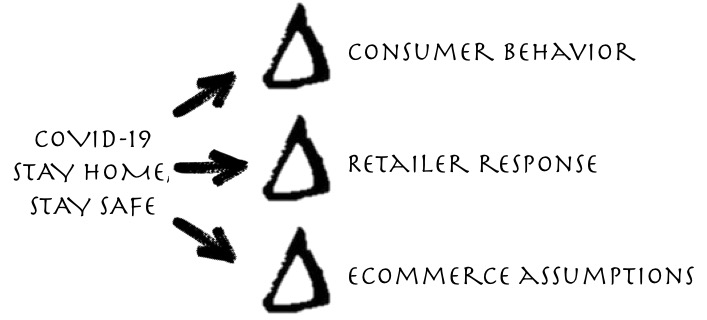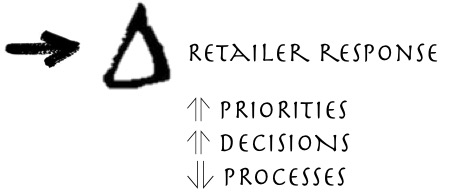COVID-19’s Effect on Customers, Retailers and Ecommerce Platforms
COIVD-19 and Ecommerce

COVID-19 is decimating economies, businesses and supply chains globally. Retail and direct to consumer brands are at the sharp end of these shifts. We are now in a period of enforced change, for the adventurous, it’s a time of opportunity.
Overnight changes in consumer expectations and behaviors have inspired agile and creative responses. Platform vendors quickly shifted focus to support new priorities.
Ecommerce Systems are being pushed to their limits by the increased workload. Many systems are showing the early signs of failure that could result in expensive downtime. Keep an eye on the early warning indicators that could spell trouble.
We are documenting firsthand experiences that customers, retailers and vendors have had during the pandemic and observing how they will shape business for the next 5 years.
The Post-Pandemic Consumer

Enforced quarantining has affected us all and created an ‘average consumer’ at home. Forced to experiment by lockdown and limited supply. Brand choices, ways of shopping, and priorities have changed. Post-pandemic, some behaviors will revert and others will stick.
The post-pandemic consumer is less loyal, more concerned about hygiene and expecting new levels of convenience.
Loyalty
Customers faced with their favorite products and brands out-of-stock were forced to seek alternatives. Whether they moved from branded to generic, discount to premium or to substitute products, they discovered a new price to quality relationships.
The post-pandemic customer is more open to trying new stores, brands and products than they were before.
Hygiene
Customers followed the most efficient path for their in-store grocery shopping list. They didn’t impulse buy and they made straight for the self-checkout. Demand increased for organic grocery – perceived safer, and more likely in-stock. Online and contactless payments have replaced germ-carrying banknotes. Contact tracing applications are being proposed with little resistance and face masks have become fashion accessories.
The post-pandemic customer prioritizes hygiene and is eager to adopt new digital measures and tools to avoid infection.
Convenience
Confinement forced late adopters of technology to shop online, even for grocery. Customers tried and loved in-store or curbside pick-up. Deprived of bars, and theaters, consumers are downloading, watching more subscription services and playing more games. They walked, ran, cycled and baked bread and played games as families. Leisure time has been re-valued.
Post-pandemic consumers expect and pay for goods and services delivered quickly at their convenience. Shopping is less of a leisure activity.
The Post-Pandemic Retailer

Our conversations with retailers and vendors yielded rich insight into both the struggle and the new opportunities. Consumer demand has been difficult to predict with both shortages and restrictions on what can be sold. Labor shortages, brand reputational damage and sales erosion have been dramatic concerns.
However, ecommerce sales have increased significantly during this period and there will be a persistent change to online/offline split. All these factors have already impacted priorities, decision-making and business processes.
Retailers who had invested in omnichannel are more likely to survive the pandemic and their processes will be more agile and evolved.
Priorities
Competition for customers is harder and survival stakes are higher. Retailers hustled in every way possible. In-store pickup was ramped up, home delivery was scaled and retailers sought zoning help to turn stores into distribution centers.
Staff were dropped into new roles with new systems and processes. Retailers used analytics to understand the effects on revenue models, and how to promote the products that customers needed. Scalable and reliable pick, pack and last-mile fulfillment was the priority.
The post-pandemic priority is to optimize and refine new channels and payment methods for profitability and convenience.
Decision-Making
In unpredictable conditions and unknown timeframes, retailers have closed stores, furloughed staff, and disposed of perishable products. Stores converting to distribution centers, adding order routing, electronic payments, and curbside pick-up were accomplished almost immediately . Teams were instantly began working remotely and decision-making is now focused, fast and firm. Outcomes of those emergency decisions are being evaluated and corrected where required.
Post-Pandemic retailing will employ leaner decision marking, be more data driven, and with accelerated and autonomous processes.
Processes
Reduced sales, closed stores, furloughed staff will be common to surviving businesses. Businesses have adjusted revenue forecasts for the year. Recovery plans will re-open stores, re-hire associates and to service latent demand for products.
Retailers are acknowledging employees: lost to COVID-19; who worked through the crisis; and who are being rehired to rebuild business. For surviving businesses and those who are hired from businesses that failed lessons were learned regarding resilience and agility.
Post-pandemic organizations place a focus on employee wellbeing and on preparedness of processes and systems
Post-Pandemic Ecommerce

Omnichannel ecommerce has been system and market tested through myriad permutations. Scalability and flexibility of infrastructure, applications, physical facilities and customer facing processes is well understood. Now field-proven and accepted by customers omnichannel retailing will be the norm.
Post-pandemic retailers and vendors are partnering to ensure system performance, support of merchant features and robust technology infrastructure.
Platform Performance
Ecommerce sales and omnichannel fulfillment took a sudden jump. Large retailers’ operations rooms went code-red as system alerts threatened sales. Platforms, integrations and third-party services were faced with peak operating conditions, accelerated addition of new-features or configurations and a range of unplanned exceptions. Strong relationships with systems vendors and implementation partners enabled faster issue resolution
Post-Pandemic ecommerce teams are paying more attention to conversion site stability, speed and user limitations at peak and supporting a new set of edge cases.
Merchant Priorities
At the height of the pandemic, site merchants focused on getting people to products and products to people. Shopping became an essential activity and the focus was on availability and reliable fulfillment. User experience, marketing promotion, merchandising finesse was de-prioritized. Merchandising teams worked in overdrive to keep the stores functional.
Post-pandemic, site merchants are revisiting their sites to make them more shopable and competitive once more and they are demand more effective tools and a better user experience.
Technology Considerations
Technology operations, project management and vendors partnered closely to maintain site uptime and performance. They found themselves blocking and tackling a broader range of problems from converting stores to fulfillment centers, adding order routing, adding payment methods. This was all done in accelerated timeframes with all hands on deck.
The post-pandemic operations team is reviewing at ageing codebases, ease of integration, availability of APIs. Security compliance and leveraging up to date infrastructure components are also priorities.
Post-Pandemic Re-Platforming
Business performance during the pandemic has made retailers acutely aware of the points of failure of their ecommerce processes and systems. Trusted vendors and implementation partners have proven their worth.
Post-pandemic plans include reviewing recently added integrations and platform features. Comprehensive systems health-checks and investigation into replacing ageing systems to support recovery and growth.
A formal RFP process ensures that the long term business needs from all stakeholders are included in the decision making process. The strategy is find and select vendors who are reliable long term partners for critical systems.

